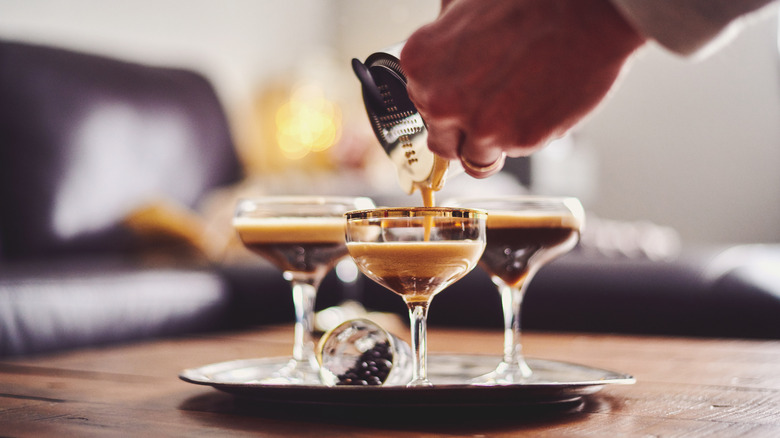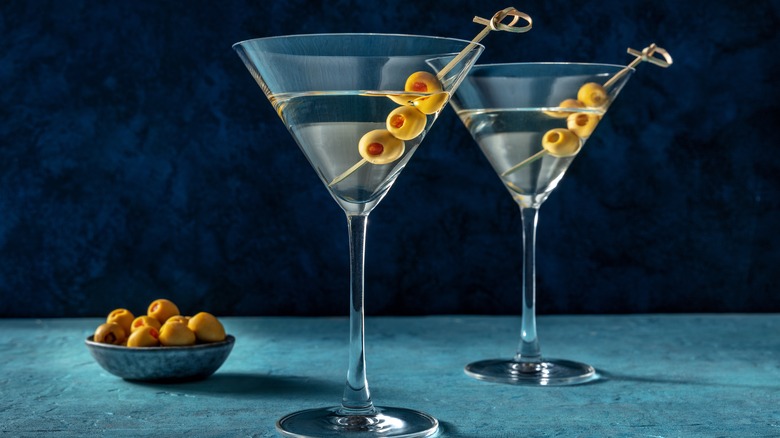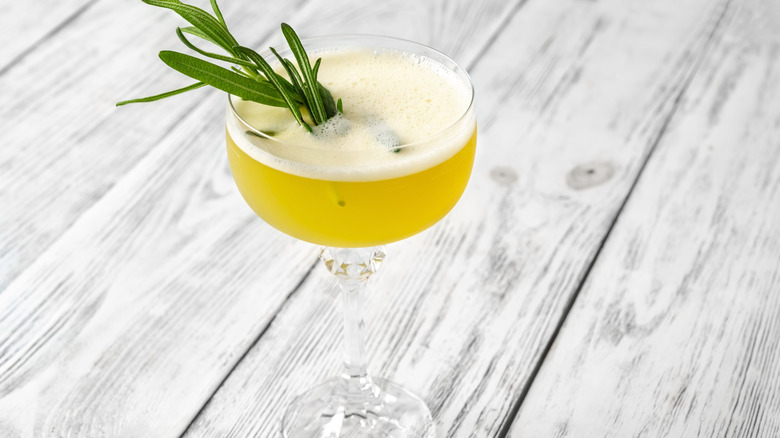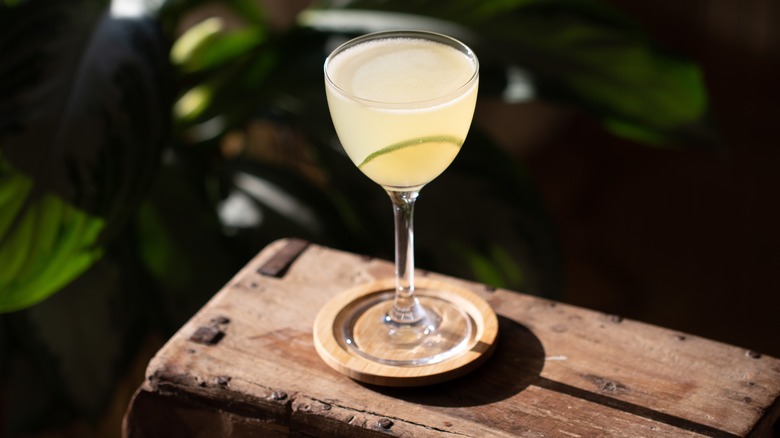3 Popular Types Of Martini Glasses, Explained
Bring up a martini emoji on your smartphone, and you'll see the familiar V-shaped glass that's so associated with the cocktail that few may remember it's only one of several glassware options for martinis. In fact, martinis pre-date the iconic glass by four decades or so, with the cocktail invented in the 1880s and V-shaped glasses in the 1920s during Prohibition. Because gin was easier to manufacture than other then-illegal spirits, it became the dominant drink in a range of gin cocktail recipes and drove up popularity of the martini — as well as the glasses that served it. Even then, it still vied with other popular martini glasses, and the passing decades have witnessed to-and-fros of popularity.
Martini glasses essentially break down into three types: V-shaped, coupe, and Nick and Nora. The first is the familiar, thin glass with the long stem reaching up to a cone with straight sides. The coupe — probably the oldest cocktail glass in history — begins with a similar wide base and thin neck but opens up more to a sturdier, rounded, shallow bowl. The Nick and Nora — named for a boozy crime fighting couple in a popular 1930s book and film series — extends the sides higher from the rounded base, putting it somewhere between the V-shaped and coupe. Whether following a dry or dirty martini recipe, you can find a host in any of these three styles of martini glasses and add them to your collection of cocktail glasses.
The V-shaped martini glass
The most recognizable of the three types, the V-shaped martini glass reflects both the era it was invented in and the properties of gin. The design and shape of the glass draws heavily from the straight-edged art deco movement of the time. It debuted at the 1925 International Exhibition of Modern Decorative and Industrial Arts as a then-modern take on the traditional coupe glass. Because gin is a spirit best served cold, the long, thin stem works to keep hands off of the cone itself, which could heat up the gin, especially when flapping the night away in a speakeasy. The wide mouth of the V-shaped glass suits gin, too, as oxygen exposure brings out the aromas and flavors inside.
Most of the downsides of V-shaped martini glasses are for the bartenders. Because they are so heavy up top, wide in the mouth, and straight in the edges, they all-but launch the gin and vermouth out of them onto the bar, table, and surrounding people at the slightest bump or nudge. This also makes the glass ludicrously easy to smash. The V-shape fairs nearly as bad in storage, as the shape and size takes up a lot of space and may not even fit in existing shelves and cabinets. On the drinker's side, they require a steady hand and impressive balance to even bring to the lips without losing a drop — a skill quickly diminished by the martini itself.
The coupe martini glass
This cocktail glass can claim seniority on everyone. It was once erroneously thought to have come from 17th century France as a glass for Champagne that drew inspiration from Maria Antoinette's breast. Unfortunately, the facts bust the myth, as the coupe was actually invented 100 years earlier in England by a Benedictine monk. By the 20th century, it served as the de facto glass for many cocktails, including the martini, and has gone in and out of fashion in the decades since, coming back in style notably during Hollywood's golden age and the current trend for artisanal spirits and cocktails.
That's partly because the wide but shallow bowl lends itself well to flights of fancy and experimentation, particularly when it comes to presentation and garnishes — including martini olives. Mixologists can also feel more confident that the drinks will stay put, as the curvature of the bowl and overall stability of the glass make the contents more secure. The wider brim is another bonus as it opens up aromas and gin flavors. The downside of this glass applies more with carbonated drinks like Champagne or a gin fizz, which lose bubbles faster in a coupe.
The Nick and Nora martini glass
In the 1930s, everybody's favorite husband-and-wife detective team was Nick and Nora. Birthed in the Dashiell Hammett novel "The Thin Man," the suave, snappy, wise-cracking couple became national sensations when the movie of the same name came out in 1934 and even more so in the sequels to follow. Cocktails featured high among their arsenal of crime fighting tools, so much so that they inspired their own martini glass, the Nick and Nora. A cross between the coupe and the V-shaped glass, the Nick and Nora combine the roundness of the coupe and the height of the V to create a half egg-shaped cup atop the stem and base, almost like a petite wine glass. However, it wasn't until the opening of the famed Rainbow Room in New York City in the late 1980s that the Nick and Nora name was stamped on the glass style.
Those cinematic and cultural connections add a dose of elegance and nostalgia to the Nick and Nora on top of the sturdy design that suits spirit-forward and stirred cocktails. As the mouth is more closed than V-shaped or coups, it helps keep the drink cold longer, but it's still wide enough to release the flavors and aromas. However, that may appeal less than the coupe or V-shaped to bartenders hoping to make a presentation splash or mixing cocktails with foam and other toppings, which may not fit as well in a Nick and Nora.



